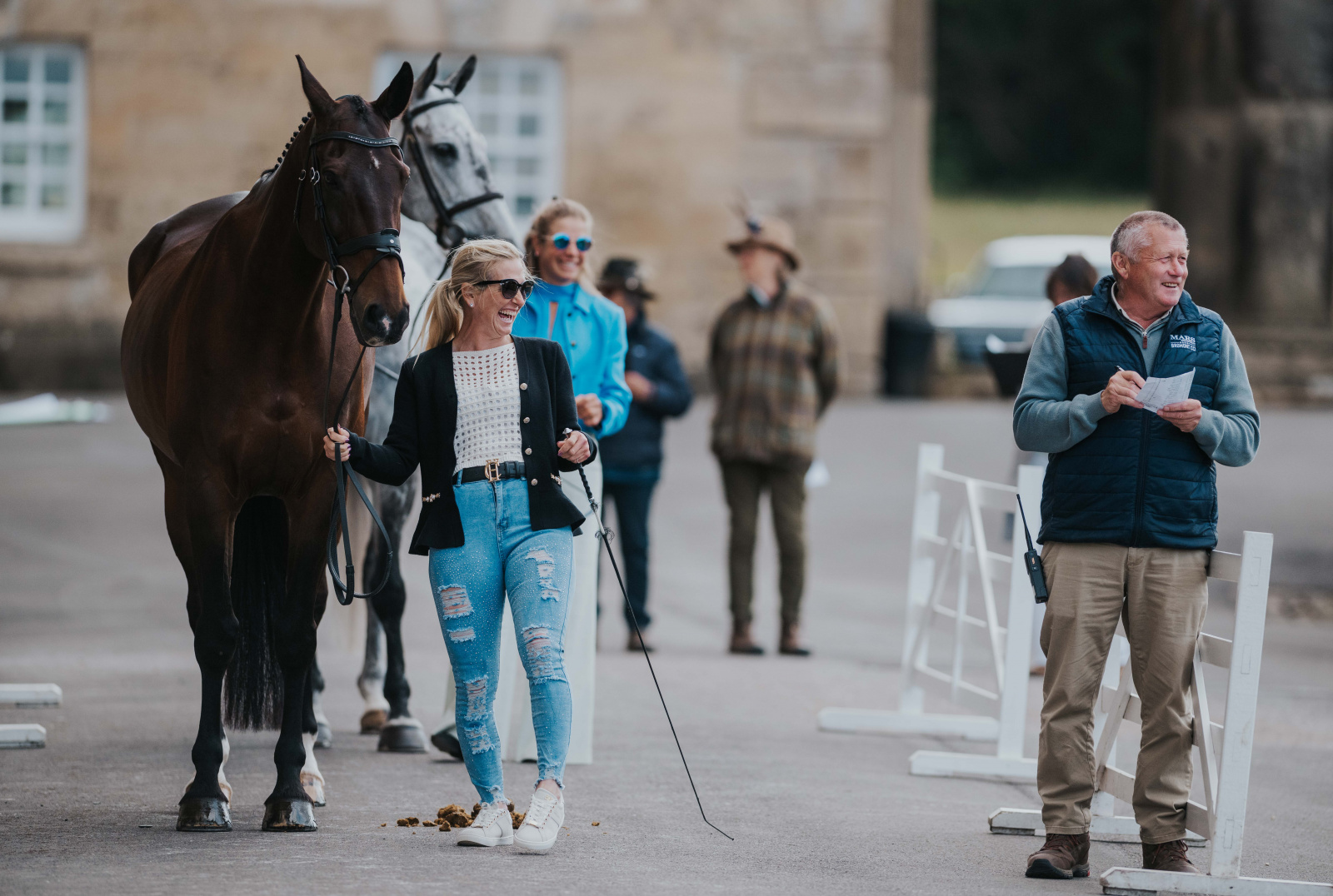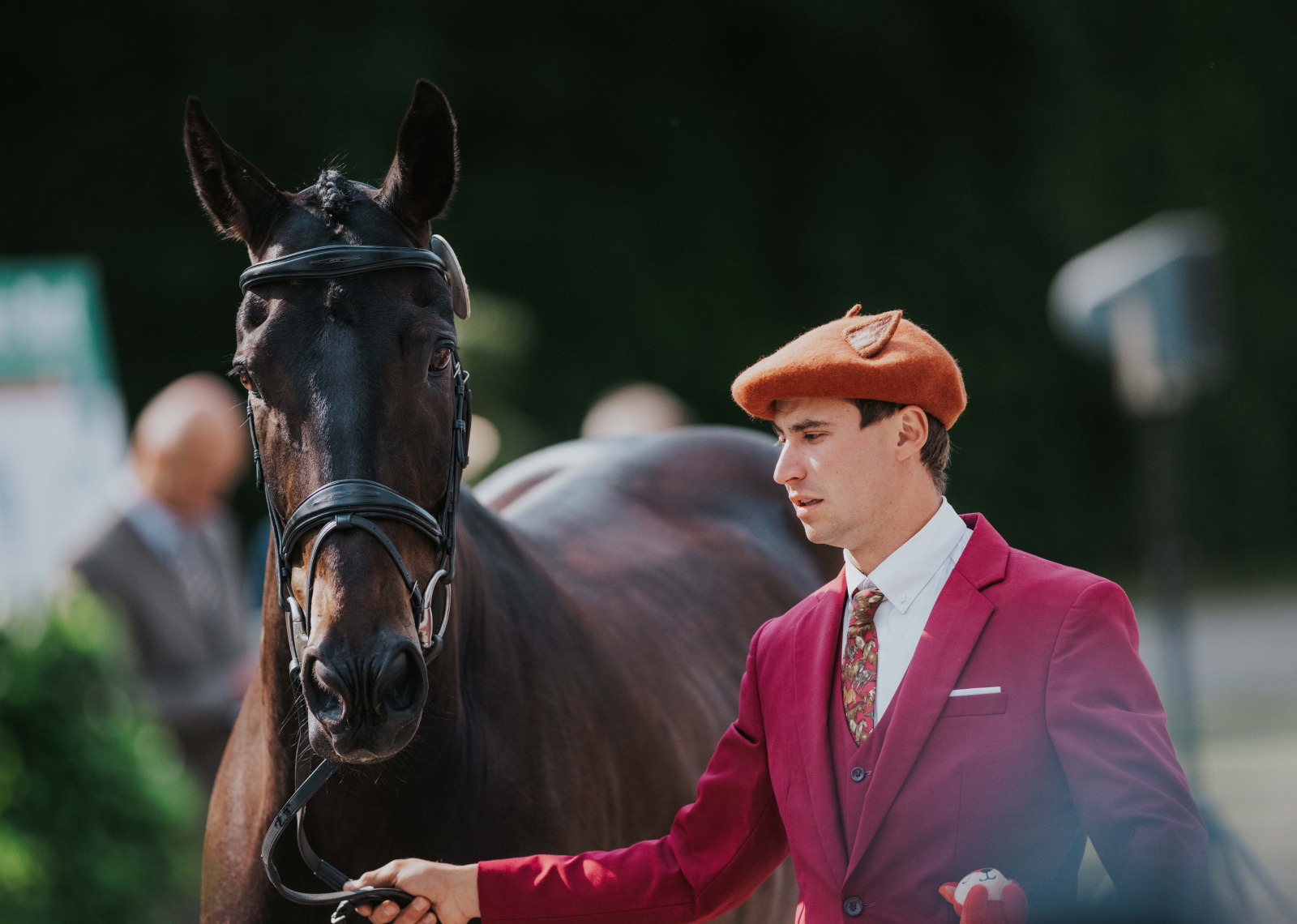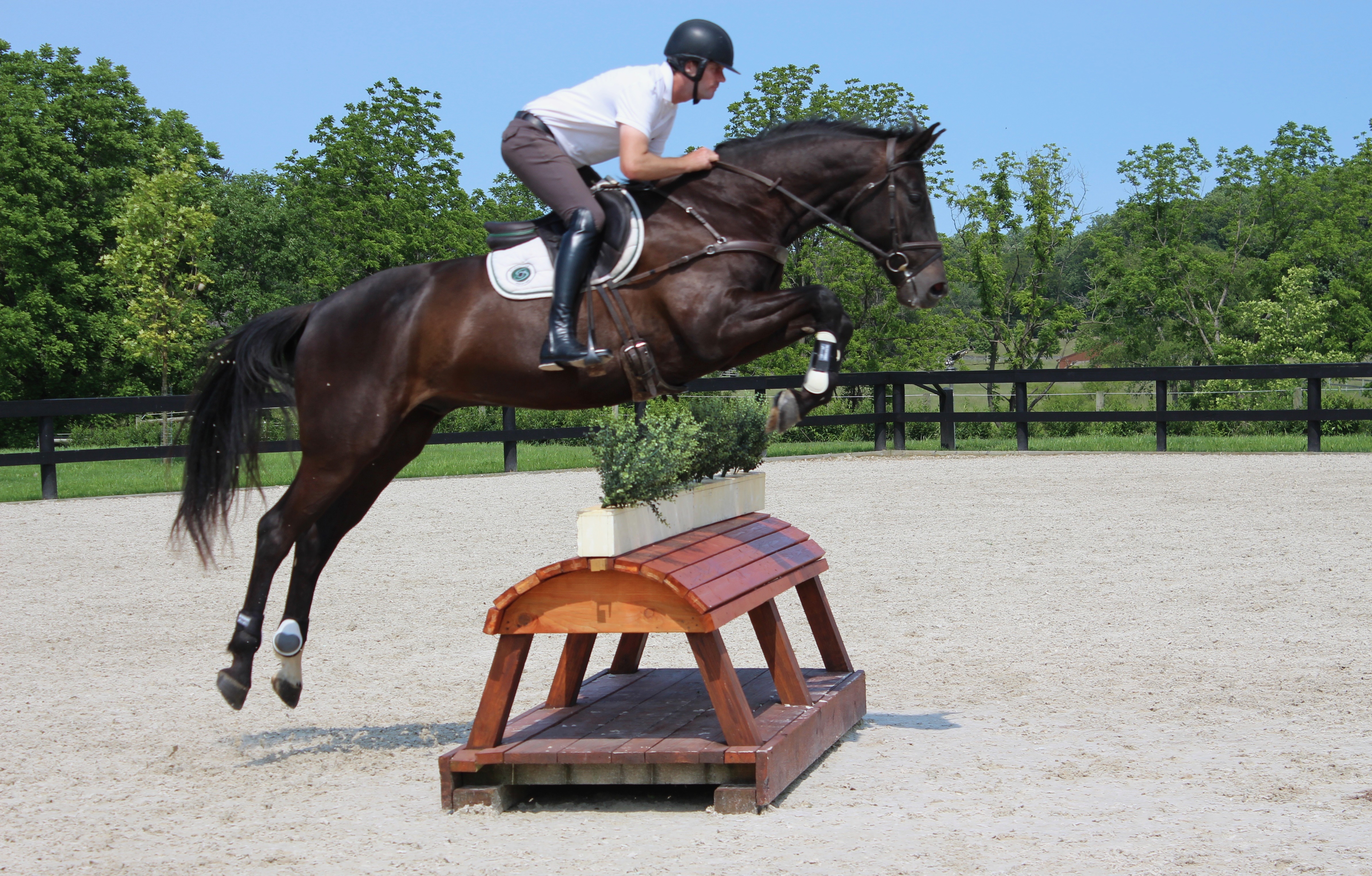
Bubby Upton and Its Cooley Time. Photo by 1st Class Images.
Thursday’s CCI4*-L leaders at the Defender Bramham International made a strong bid to stay at the top of the leaderboard with their score of 24.6 – but today, Sarah Bullimore and her homebred Corimiro would be pipped at the post, just barely, by another British combination in Bubby Upton and Its Cooley Time, who put up a smart 24.4 to lead at the end of the first phase.
Bubby, who won the under-25 CCI4*-L here in 2023 with Magic Roundabout, hasn’t finished outside the top ten with Its Cooley Time in nearly two years, but while the ten-year-old steps up to CCI4*-L looking like the consummate competitor, Bubby tells us that he’s not always been the most straightforward horse to ride.
“I actually spoke to Ros [Canter] a lot about him, because I think he’s so similar to Izilot DHI,” she says, referencing Ros’s famously sharp and spooky five-star winner. “Luckily, though, he’s grown out of it a bit quicker than Izilot!”
“He’s an incredible horse, and the one trait he’s never lacked is talent, but it’s taken a long, long time to get his head in the game,” she says. “He was unbelievably sharp as a youngster, and I’m so pleased that basically since he was a seven year old, he’s come good.”

Bubby Upton and Its Cooley Time. Photo by Hannah Cole Photography.
The son of Quality Time TN led the dressage at the British Seven-Year-Old Championships in 2022, ultimately finishing seventh, but Bubby opted not to aim him for the Young Horse World Championships at Le Lion d’Angers, in fear that the huge atmosphere there would overwhelm his sharp brain at too young an age.
“Osberton was the first time I thought, ‘we’re actually getting somewhere,’” she says. “Mentally, the focus, too, on cross-country kind of came from that point onward, but I always took him very steady, because I didn’t want to expose him to too much atmosphere too soon. He was the kind of horse who I felt would just go the other way, and I didn’t want to undo all the time and patience that we’d given him and go ten steps back.”
It’s clear that now, a little older and a little wiser, he’s ready to repay that kindness – and today’s result feels like the start of a redemptive arc after a lost opportunity last season.
“He was the favourite to win the eight- and nine-year-old class at Blenheim [in September], but he got a skin infection that took way longer than we’d hoped to clear up,” laments Bubby. “He was meant to do Boekelo [CCIO4*-L] as well [in October].”
So: a longer, slower start than planned. But, she continues, “he’s a horse who’s just forced me to improve and adapt as a rider more than any other horse. He goes in a completely different way to any of my other horses. I always describe him as a freak of nature, because when you watch him go cross-country you think, ‘god, that horse goes so low, how does he leave any poles up?’ And then you watch him showjump and you think, ‘that horse goes so high – he’s a freak and couldn’t go cross-country!’ So he’s got it all, he really has. It’s just taken time and patience; at home, he’s so badly behaved and naughty, and he spooks at the same thing every single day, but you just have to ignore it, because now he also knows the job and he goes in there and he delivers.”
Of tomorrow’s famously enormous cross-country track, now newly designed by Andy Heffernan after the retirement of Ian Stark last year, Bubby’s full of nothing but praise.
“I think Andy’s done an incredible job – major hats off to him, as following Ian is no mean feat,” she says. “He’s put his own twist on it as well – like, he’s used parts of the ground and places where we’ve never had combinations before. For example, coming home, [when I walked] I got to the top of the hill after the last water and was a bit disappointed there wasn’t a combination there, and then got to the top of the next hill and said, ‘Ah, here we go!’ He’s been arguably even more clever and tough on us, because we’ve had to climb two more hills and then have another combination. So I think it’ll be a real test of stamina, and, as always here, bravery – combined with accuracy and technicality. I’m really excited for the challenge.”

Izzy Taylor and SBH Big Wall. Photo by Tilly Berendt.
Izzy Taylor and the rangy ten-year-old SBH Big Wall – a son of Puissance, you’ll perhaps be unsurprised to hear – will go into cross-country in third place after a smart test for 25.4, one of his best-ever scores at the level.
“I think my highlight was his attitude,” says Izzy, who won this class in 2022 with Monkeying Around, and who comes here with this horse off the back of a second-place finish in the CCI4*-S at Belsay last month. “I’ve always loved this horse, and I’ve had him since he was a four-year-old, which makes it very special. It makes the job easier, too, because we really know each other so well – the good bits and the bad bits.”
In his test, she explains, “he stayed really rideable the whole way through; he had a little spook, but that’s just in his character, so it’s part and parcel of it. He loves his job – he gets in there and says, ‘hey, can you look at me now?’”
In his third season at four-star, precocious SBH Big Wall is ready to step into his prime – and, says Izzy, she always suspected he’d pull all the pieces of the puzzle together.
“It’s his brain. He was a very ugly duckling – to be polite! – and the looks have improved with age, but he’s always had a great brain,” she says. “He very much wants to do right. He gets annoyed with himself – and sometimes with me! – when it’s not quite what I want, but that’s such a rare occasion. He’s just very chill and loves his job. You can teach a horse to love his job, but when he loves it from the word go, that’s a lot easier.
Sweden’s Louise Romeike and Caspian 15, who were longtime leaders yesterday and then settled for second overnight, go into cross-country in fourth place on 27.4, while 22-year-old Barnie Brotherton and DHI King Nelson round out the top five on 29.4.
New entrants to the top ten today included Caroline Harris and Cooley Mosstown, sixth on 30.2, and Tom Jackson and United 36, seventh on 31.1. We caught up with Caroline after her competitive CCI4*-S test on Pau champion D.Day, so keep reading for some of her thoughts on the day.
Eighth place is the provisional domain of Daisy Berkeley (neé Dick) and her Blenheim CCI4*-L runner-up Diese du Figuier, who posted a 31.4, while Aimee Penny and Freshman HH put a 31.9 up for ninth. The top ten at this early stage is rounded out by Japan’s Toshiyuki Tanaka and the former Chris Burton and Bubby Upton ride Jefferson JRA on 32.

The top ten going into tomorrow’s cross-country in Bramham’s CCI4*-L.
Nobody could catch day one leaders Sebastien Cavaillon and Elipso de la Vigne of France, who retain the overnight lead on a score of 26.9 as they head into tomorrow morning’s showjumping and then the afternoon’s cross-country in the CCI4*-S class – but some smart partnerships came very close.
Chief among them, and a pair that drew plenty of spectator interest, was Piggy March and new ride MCS Maverick, who won the CCI4*-L here two years ago with Pippa Funnell aboard. It was on Pippa’s suggestion that ‘Eric’ make his way into Piggy’s string, into which he was secured by a group of owners cheerily dubbed ‘The Maidwell Mavericks’.
Now, they find themselves in second place going into tomorrow’s finale on a score of 27.5 – but, Piggy admits, she considered not even bothering with the test today.

Piggy March and MCS Maverick. Photo by Tilly Berendt.
“To be honest, I’ve been absolutely shitting myself all morning,” she deadpans. “He’s hated doing the arena familiarisation – hated it. Last time he was here he won the long-format with Pip, so he did a lap of honour, and he’s just been fairly terrified going in there. I’ve had some hot ones before, but I’ve never had one where it feels like his eyes and his brain are spinning at seven o’clock at night with no atmosphere and a load of his mates walking around with him. I actually had to get off – I’ve never got off one in an arena familiarisation before.”
“You normally think you can just walk around in there and have a chat with someone,” she continues, “so I was a bit like, ‘fuck, this is going to be a nightmare.’ So I did ring Mrs Funnell this morning, and I was like, ‘do I need to put you on the loudspeaker, Pipsy, and you can just whisper the stuff you used to whisper to him?!’ I just thought, ‘is this even going to happen?’”
Rather than over-the-phone seances, though, Piggy opted to repeat the long, slow, tactful routines that Pippa used with the gelding. That is, lots and lots and lots of time spent outside the stable, walking and grazing, and being allowed to stretch himself out on the lunge and take everything in, because, as she says, “he’s a lovely horse who’s been produced by the best rider in the world, but he’s clearly very sensitive and he gets wound up by an occasion very easily.”
Producing a test in this ring was also such a key part of her longer-term plan to get to know the horse, and so she didn’t want to give up and give in just yet.
“There’s nowhere that’s quite as atmospheric as in there – probably not even Badminton and definitely not Burghley, because the audience isn’t as close as they are here. And I really wanted to see him at his worst, which I’ve definitely seen over the last 24 hours,” she laughs. “I don’t care about winning a ribbon here, but I do want to take him to Burghley in the autumn, and so this week is about figuring a lot of things out, and one of those is how to deal with all this. So I wanted to go in there today and really ride him, and ask him for more, and see what he gave me.”
Most of what that ended up being was surprisingly calm, pleasant work, but the minor mistakes – some near-jog steps in the walk, and a too-early change – were great chances for Piggy to put a bit of gentle pressure on and see how Eric would respond.
“It was a great training exercise. I was determined not to back off with my leg in the walk, even if it meant we had a hurried walk – I wanted him to walk on and let me ride him,” she says. “And when he threw in a change too early, if it was Burghley or a Championship I’d have had to take it and keep riding, but today I’m training, and so I wanted to bring him back, let him know I hadn’t asked for that, and ride it again, and he took that on board so well.”

Yasmin Ingham and Gypsie du Loir. Photo by Tilly Berendt.
World Champion Yasmin Ingham holds third place overnight with the exciting nine-year-old up-and-comer Gypsie du Loir, with whom she posted a 27.9.
“I’m really pleased with that – she’s such a talented young horse, and I’m really excited about her for the future,” says Yas, who has already won at CCI3*-S and CCI3*-L with the mare. “We’re working on establishing her in the more difficult movements at the four-star level, so the changes, the half-passes – I’m delighted with that, actually. She’s got beautiful paces and a great presence in the arena, and she’s a pleasure to work with, so I feel very lucky to be riding her.”
Gypsie du Loir, who, like Yas’s top horse Banzai du Loir, was bred by Pierre Gouye is “actually surprisingly quite sharp,” says the rider. “She’s quite blood, so she does take a bit of work before the dressage. I think it’s just about getting her confidence now with these movements, and I really do believe that in a couple of years’ time she’s going to be a force to be reckoned with.”
The pair come to this event off the back of a top-ten finish in the very terrain-heavy, tough CCI4*-S at Bicton, which was the mare’s second run at the level, and Yas added her voice to the many in praise of Andy Heffernan’s debut designing effort that they’ll jump tomorrow.
“I’ve not been here for a few years, and Andy’s now taken over as designer – but it looks fantastic, and I have huge confidence in him. He trains me a lot at home, so I feel very lucky that I’ve had his help, and he’s produced a brilliant course that I can’t wait to tackle.”

Astier Nicolas and Alertamalib’or. Photo by Hannah Cole Photography.
France’s Astier Nicolas will sit fifth going into tomorrow’s jumping phases with the hugely experienced Alertamalib’or, with whom he posted a 28.1 before the lunch break. The fifteen-year-old Anglo Arab, who was the 2017 Seven-Year-Old World Champion, and represented France at the 2022 World Championships, is among a smart lineup of French horses entered here with, potentially, a European Championships bid ahead of them later on this year.
“This is the second event of the season for him, and the French delegation all came here so we can ride three phases on grass, and over a course of this style, with the aim of the Blenheim Europeans,” he says. “So far, so good – he was really with me and gave me a good feeling. It was pretty consistent; he’s not a great, flashy mover, so that wouldn’t show as a highlight, but the feeling he gave me was pretty nice.”
Alertamalib’or is, Astier says with a grin, “a human – he’s very arrogant! But it’s funny – all the weak sides you don’t like in humans, when an animal has it, you think they’re very clever and you’re much more sympathetic to it. It’s all about him; he’s very expressive, and he loves contact with humans. He’s like a pet.”

Tiana Coudray and Coeur de l’Esprit Z. Photo by Hannah Cole Photography.
US Olympian Tiana Coudray slots into sixth place, behind under-25 leaders Tom Woodward and Low Moor Lucky in fifth, at the culmination of the first phase with Coeur de l’Esprit Z.
They put an impressive 28.7 on the board – a four mark improvement at the level, and the gelding’s first time hitting the sub-30s at four-star. But was the Wiltshire-based rider expecting the gelding to throw down such a significant personal best today?
“Not at all!” laughs Tiana. “I mean, he’s a mega horse, and he’s so flashy, and we have big hopes for him, but he’s still weak in his body and he’s sensitive in mind, so it’s all time with him.”
She’s had the ride on ‘Eyeballs’, as he’s known at home (that’s thanks to his perpetually rather startled appearance; he looks, at any given moment, as though he’s just achieved sentience) since he was a five-year-old, and though she rates him as a real star of the future, producing him has been a labour of love and patience.
“He’s so sensitive in his mind that it’s been two steps forward, one step back – life is just difficult for him, but he does show up, and he does try, and he really wants to be a good boy. He’s such a classy animal, so you’re happy to keep plugging away,” she explains. “He’s an immature ten-year-old, but he’s a championship horse through and through. Of course, when you have one of those, the phone never stops ringing [with potential buyers], so I have to be realistic, but I also have to dream.”
The son of Connor 48 made the step up to CCI4*-S just under a year ago, closing his season out with a steady, sensible run in the eight- and nine-year-old class at Blenheim – where, Tiana says, “He was flashy and he was promising, but he was weak, and that takes time to develop.”
Like that Blenheim outing, Tiana’s approach to Bramham is all about the future, not about trying to make any major waves this week. And so, in keeping with that mindset, she’s planning to give the young horse the ride he needs, not the ride the leaderboard might demand.
“It looks really beefy out there [on the course], but you don’t come to Bramham expecting any different. He’s quick, he’s nippy, he’s careful, and he’s scopy, so any issues would come down to immaturity and greenness. I’ve never known anything as quick as him, but I also have to be careful about pushing the button too early, because at the moment, the mind doesn’t go as quickly as the body does,” she says. “[This week] isn’t about Bramham 2025 – it’s about what he might do down the road. So we’ll see! Hopefully we’ll have a decent crack at it, but we might just keep it two gears down from what he can do.”

Caroline Harris and D. Day. Photo by Tilly Berendt.
Caroline Harris and her 2024 Pau winner D.Day made an early bid for a placing this morning when they delivered a smart, sensible test for a 29.7 – good enough to see them sit seventh going into tomorrow’s finale.
The fact that the test was so sensible was a highlight and a relief for Caroline, who found the eleven-year-old gelding “quite wild” at last month’s Belsay International.
“To be honest, I think it was the galloping around [in the prizegiving at Pau] – now, he thinks he’s amazing, and so he went into the main arena there and thought it was time to gallop around again,” she laughs. “He wasn’t awful, he was just excited to be there; today, though, he was much more relaxed.”
That newfound self-belief has been the biggest change that Caroline has seen in the petite gelding since his career-defining victory, which the pair achieved in unprecedented slop in France in October.
“He’s come out quite arrogant [this season], whereas before he was so timid and like, ‘oh god, I’m not sure about this!’,” she says. “He’s not the most naturally confident horse, but it’s definitely given him the self-belief and arrogance to go, ‘actually, I’m alright.’”
With a five-star win under his belt at the end of his ten-year-old year, it wouldn’t, perhaps, have been a surprise to see Caroline aim D. Day at Badminton this spring. But she was determined not to get ahead of herself, and to continue the young gelding’s long-term production sensibly.
“I was very adamant that I didn’t want to go to Badminton, because I knew it wasn’t the right thing for him,” she says. “He’s a super little horse, but I think both of us just need another year [of experience]. I’m very green at five-star, and he’s not the most naturally brave. When he’s going well he’s amazing, and I’d only want to go to Badminton knowing he felt on fire. So this year, I’m gunning for Aachen [CCIO4*-S in July], because I really think it would suit him if we were to be selected. Otherwise, I want to bring him to weeks like this where can get more exposure to bigger tracks and atmosphere and just learn more.”
Eighth place is held overnight by Emily King and Jackpot on a score of 30, while Alex Hua Tian holds ninth and tenth places with Chicko (30.1) and Poseidons Admiral (30.6), respectively.
Tomorrow’s jam-packed day will see the CCI4*-L head into cross-country from 9.00 a.m. BST (4.00 a.m. EST), while the CCI4*-S will showjump in the main arena from 8.30 a.m. BST/3.30 a.m. EST and head out onto Andy Heffernan’s terrain-y, bold, and beefy cross-country track from 12.40 p.m. BST/7.40 a.m. EST. The action will be broadcast in its entirety on Horse & Country TV, and you can get a close look at all the challenges presented on course thanks to the Cross Country App. As always, we’ll bring you a mammoth report with all the info you need to know tomorrow evening – until then, Go Eventing!
Defender Bramham links: Website | Ride Times and Scores | Cross-Country Course | Live-Stream | EN’s Coverage















































































